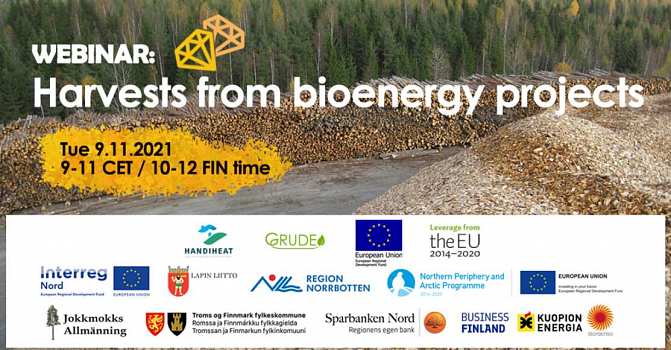Bioenergy in transition
Several bioenergy related topics have been discussed in the media lately: EU legislation guiding use of wood towards value-added products, stopping peat burning and how to replace it, and what could be the role of biogas in national energy system. These topics are all very relevant. However, while aiming towards carbon free energy production and use, the causal relationships between different choices should be understood, and the current available and affordable options should be used in the best possible way.
Webinar: Harvests from bioenergy projects 9.11.2021
What could bioenergy offer, and how to get most out of biomass is discussed further in the webinar: Harvests from bioenergy projects 9.11.2021 at 10 Finnish time, organized by GRUDE – Green Rural Economy and funded by Interreg Nord program. Registration and program. Welcome!
In Finland, wood fuel based bioenergy production provides us a high share of renewable energy in energy production and consumption. From the total energy consumption (356 TWh), wood fuels covered 28 percent and other renewables 12 percent in 2020. Wood fuels are classified under black liquor (44 TWh), wood fuels used in industry and energy production (39 TWh), and small-scale combustion of wood (16 TWh). The last has been used particularly in district heating.
Cascading use instead direct energy use of wood still needs time to adjust
There is pressure to both increase and decrease the use of wood fuels in energy production. Finland has decided to stop burning coal in 2029 and to cut burning peat at least by half by 2030. Although, due to growing taxes and prices in emission trading, burning peat might decrease even by 75 percent already by 2025. Wood could replace coal and peat in district heating. However, at the same time EU is planning to tighten the sustainability criteria for renewable fuels and aiming towards cascading use of wood instead of direct burning. While the principle is good, it might not be economically feasible without large enough production scale, and thus, leaving e.g. side-streams from local saw mills out of the reach for cascading use.
Imported wood chips currently replacing peat in district heat production
The use of peat for energy production has been between 15–17 TWh already for several years. After the new government programme was released in 2019, the peat energy use dropped from 16 TWh in 2019 to 12 TWh in 2020. Peat has been used mainly in district heating where it has had a central role to secure the heat supply. The phasing out of peat has increased the demand for wood chips, although the gap could be covered also with other heat sources. Already in 2019, heat recovery and heat pumps provided ca 10 percent of district heating. Even geothermal heating and small nuclear power reactors are considered for heat production. The problem is that the on-going transition is too fast for new technologies to be taken into use. As an outcome from this, the amount of imported wood chips burned for energy increased by 13 percent in 2020 and was in total 1.8 million solid cubic meters equaling 3.6 TWh in energy content.

Yet another relevant bioenergy source could be biogas. It can be used as such for heat or combined heat and power (CHP) production. It can also be upgraded to biomethane and used as traffic fuel or to replace natural gas in industrial processes. Suitable raw materials for biogas production are municipal sewage sludge and biowaste, side streams from food industry, pulp and paper sludge, and agricultural residues e.g. manure, grass, straw, and crop residues. In total, these biomasses could be converted into 10 TWh of biogas yearly in Finland. This potential could be used to replace the current import of wood chips and nearly fill the gap left by peat in energy production. However, only less than 1 TWh is currently produced due to many reasons. The availability of suitable raw materials is often scattered, logistics for central plants is costly, but on the other hand small scale biogas production is challenging to get economically viable. Nevertheless, the interest towards biogas production is rising with rising energy prices. Farm-scale plants could bring the farm energy self-sufficiency and provide stable energy price. Centralized biogas plants could even upgrade biogas to biomethane for traffic fuel and industrial processes.
Role of bioenergy in the future energy system
Especially wood fuels have been used extensively for energy production in Finland. While Finland is currently getting rid of coal and cutting the use of peat, the transition towards carbon free energy production needs time to find new solutions before starting to decrease wood energy use. Even in the future, bioenergy will have an important role for balancing other renewable energy production. And not only balancing but also securing both electricity and heat supply during winter when often the conditions are not good for solar or wind power. Locally, in decentralized small-scale energy production, bioenergy provides also increased energy self-sufficiency and stable energy price.




